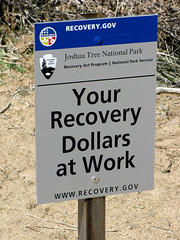Recovery Board Chairman Backs Multi-Tier Reporting
by Sam Rosen-Amy, 2/11/2011
 While the new Republican House seems obsessed with cutting federal spending back to pre-stimulus levels, it can be easy to forget that the American Recovery and Reinvestment Act is still spending money. In fact, there’s still about $100 billion in stimulus contract, grant and loan money that has yet to go out the door. And the Recovery Board, which is in charge of displaying the Recovery Act recipient reports, is still at work. This week, in a big win for transparency advocates, the Board’s chairman, Earl Devaney, announced his support for multi-tier reporting, or reporting beyond prime and sub-recipients.
While the new Republican House seems obsessed with cutting federal spending back to pre-stimulus levels, it can be easy to forget that the American Recovery and Reinvestment Act is still spending money. In fact, there’s still about $100 billion in stimulus contract, grant and loan money that has yet to go out the door. And the Recovery Board, which is in charge of displaying the Recovery Act recipient reports, is still at work. This week, in a big win for transparency advocates, the Board’s chairman, Earl Devaney, announced his support for multi-tier reporting, or reporting beyond prime and sub-recipients.
We’ve been advocating for multi-tier reporting for a while, almost ever since the Act was created. OMB Watch has long believed that true spending transparency requires knowing who receives federal funds, no matter how many hands it goes through. And that’s what multi-tier reporting does. It follows the money, regardless of how many times the project gets subcontracted, until a certain point, say when sub-awards fall below $25,000.
From the beginning, the Office of Management and Budget (OMB) interpreted the Recovery Act to only cover prime and sub-recipients, limiting the reach of transparency. In his announcement, Devaney gives an example of how the public might miss information under the current setup:
Let’s say a federal agency provides a Recovery grant to a state government, the prime recipient, and the government then distributes the funds to a city council for a local road project. The city council then sends some of that money to a contracting company. We can trace the money to those three recipients but the trails ends there. If the contractor retains a subcontractor with ties to the mayor’s brother, for instance, we have no way of knowing that unless we are tipped off.
Although this example isn’t quite accurate (we’d only have information on that third recipient if they were a vendor for the sub-recipient, and then we’d only get a fraction of the information recipients report), it gets the point across. Since a great deal of Recovery Act funding went through the states, leaving only one more level of reporting beneath them, there’s a whole bunch of sub-awarding activity going on that the public can’t see. Multi-tier reporting would solve that problem.
While the law leaves an opening for multi-tier reporting, it’s unclear if OMB will support changing the reporting structure this late into the Recovery Act’s life. Even so, Devaney’s support could be important for the larger spending transparency picture. USAspending.gov, the government’s contracts, grants, and loans database, recently started collecting first-level sub-award information, having only collected prime recipient information since its creation in 2006. Support from officials like Devaney could help push the administration towards more comprehensive reporting for USAspending.gov.
Devaney isn’t clear on specifics in his post, saying only that “you will hear more from me on this issue in the coming months.” So it remains to be seen what kind of a plan he has in mind. That said, it’s great to have a public official openly support an important transparency goal such as this.
Image by Flickr user JBYoder used under a Creative Commons license.



